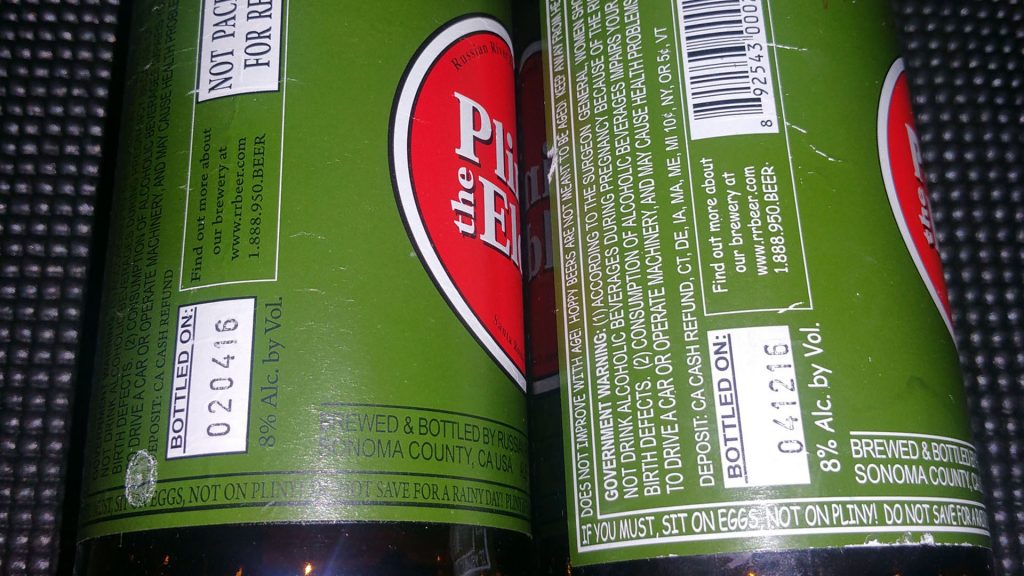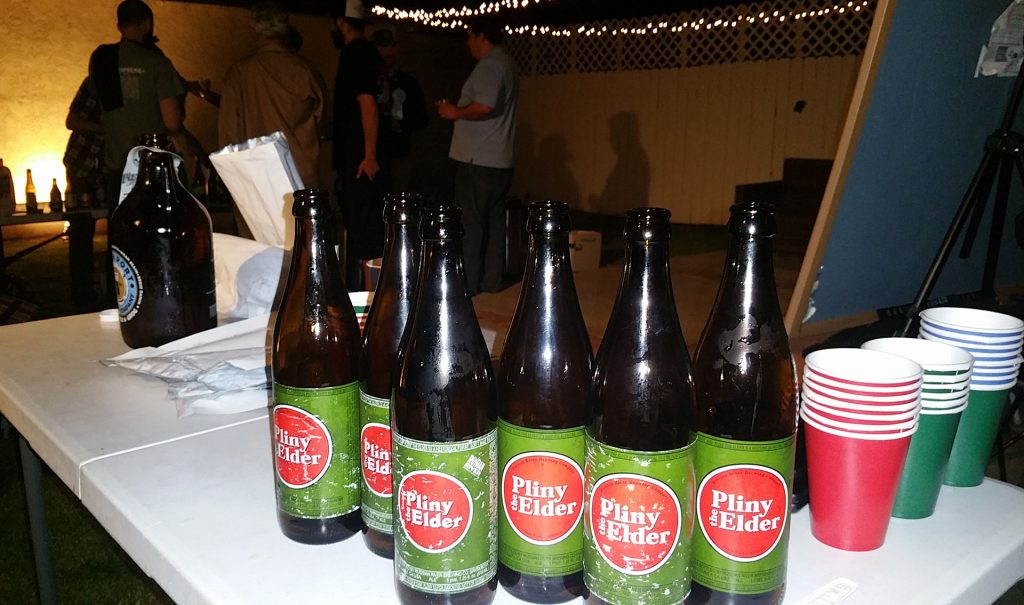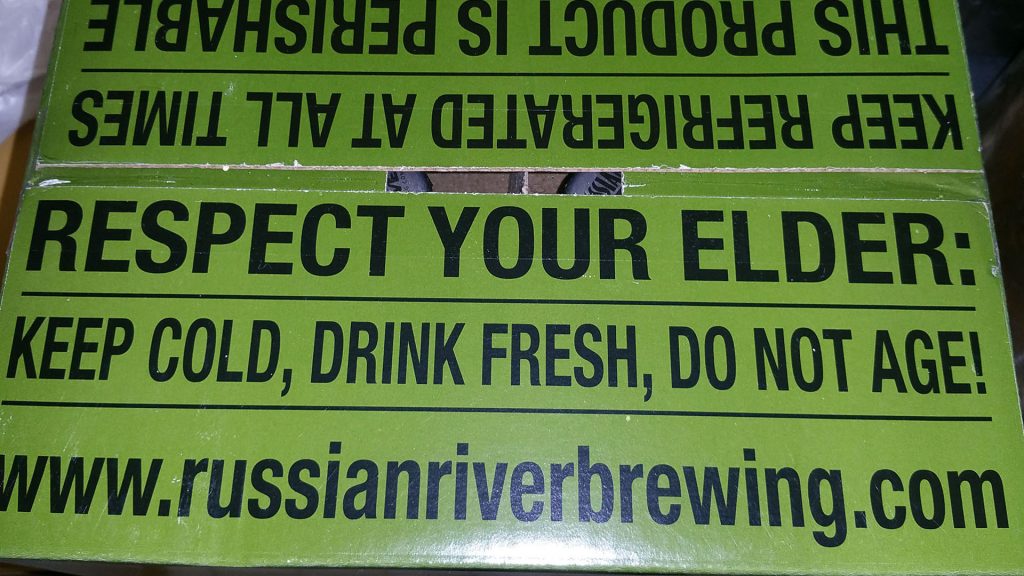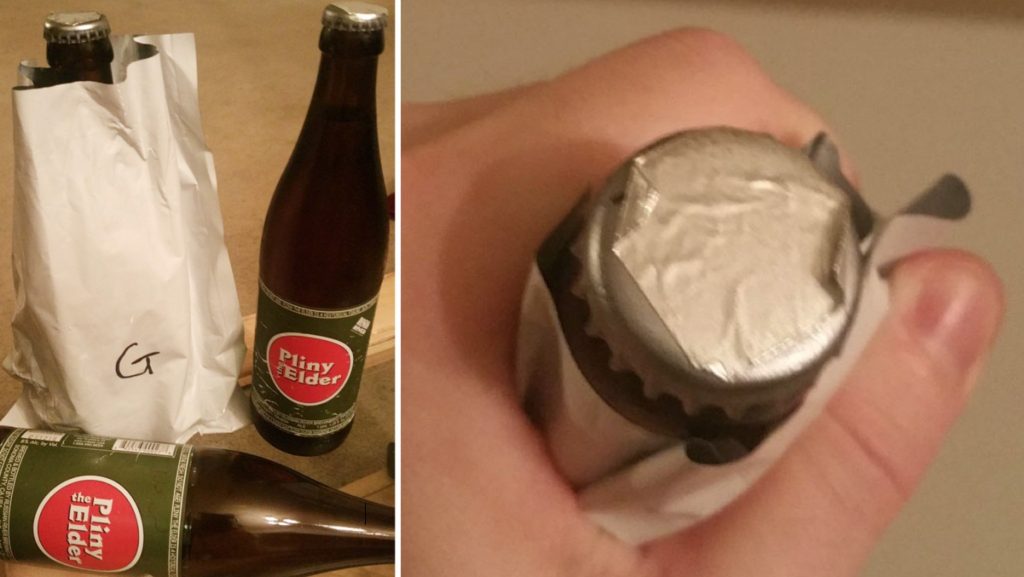Author: Greg Foster
Every beer snob knows that hoppy IPA degrades rapidly with age and must be consumed moments after bottling, lest they turn into cardboard flavored garbage. I count myself among the fresh IPA advocates, always checking the born-on date of store bought bottles to confirm they are still within the drinkability window. Some breweries even take it upon themselves to strongly request their beers be consumed fresh. For example, a box of Pliny The Elder states people must drink the beer fresh and not age it a whopping 10 times!
I recently had an experience that made me second guess this brewing maxim. I’d brewed a clone version of this delicious Russian River Brewing staple and was “blindly” comparing it to a fresh  bottle of the real McCoy packaged just 2 weeks prior. Unsurprisingly, and much to my dismay, the beers were fairly distinguishable, despite being similar in many respects. We then whipped out a much older bottle of Pliny The Elder that was packaged 2 months before the tasting. The IPA truth that has been drilled into my brain had me convinced I’d easily be able to tell the beers apart, but shockingly, I couldn’t. Was this a fluke? Could an older IPA really be indistinguishable from a fresh version? Perhaps my taste buds just aren’t up to snuff? Curiosity got the better of me and I decided to repeat this fun little exBEERiment with a larger group of truly blind tasters.
bottle of the real McCoy packaged just 2 weeks prior. Unsurprisingly, and much to my dismay, the beers were fairly distinguishable, despite being similar in many respects. We then whipped out a much older bottle of Pliny The Elder that was packaged 2 months before the tasting. The IPA truth that has been drilled into my brain had me convinced I’d easily be able to tell the beers apart, but shockingly, I couldn’t. Was this a fluke? Could an older IPA really be indistinguishable from a fresh version? Perhaps my taste buds just aren’t up to snuff? Curiosity got the better of me and I decided to repeat this fun little exBEERiment with a larger group of truly blind tasters.
| PURPOSE |
To evaluate the differences between a 2 week old commercial bottle of Pliny the Elder and an 11 week old bottle.
| METHODS |
A coupld hophead friends of mine were in Santa Rosa the week Pliny The Younger was released, so they stopped by Russian River Brewing and picked up a couple cases of Pliny The Elder. Thanks entirely to their generosity and commitment to science, they both donated many bottles of the hard-to-find elixir to my cause. Two months later, I received a tip that fresh Pliny The Elder bottles were available at a local store in my area, so I did what any self-respecting beer lover would do and immediately ditched work to buy some! The date printed on the bottles revealed the beer to be quite fresh, packaged a mere 2 weeks prior to purchase.

At just over 2 months older than the bottles gifted to me by my friends, I was comfortable enough time had elapsed for changes in character to occur. I stored both beers in the same cool refrigerator until it was time to collect data later that week. In order to preserve the blindness of participants, I wrapped the bottles in mylar bags and covered the Russian River logo on the cap with tape.
Bottles prepared, I tossed the beers in a cooler and set out to begin the great Pliny exBEERiment!
| RESULTS |
A total of 24 members of the Pacific Gravity Homebrew Club participated in this xBmt during a monthly meeting.
Each taster was served 1 sample of fresh Pliny The Elder and 2 samples of old Pliny The Elder in different colored opaque cups then instructed to identify the unique sample. In order to reach statistical significance with this sample size, 13 (p<0.05) would have had to accurately identify the fresh Pliny The Elder as being different, though only 11 (p=0.14) were capable of doing so, suggesting tasters were unable to reliably distinguish Pliny The Elder that was 2 weeks old from one that was over 2 months old.
The participants who were correct on the initial triangle test were asked to complete a brief survey on preference that included only the two different beers. Since significance wasn’t reached on the triangle test, this data ought to be taken with a grain of salt, but I thought it interesting enough to share. Of the 11 tasters who completed this portion of the survey, all still blind to the variable being investigated, 5 preferred the fresh sample, 4 preferred the old bottle, and 2 had no preference despite reporting they noticed a difference.
After completing the survey, and before revealing the nature of the xBmt, I asked club members individually what they thought of my “homebrewed” beer. Unaware of the beer’s stellar pedigree, members described it as a pretty good IPA, though no one came close to guessing that they were secretly drinking the Pliny The Elder. I finally unveiled the beer’s secret identity to an astonished crowd who, strangely, seemed quite eager to drink the leftover samples.

My Impressions: While I was unable to tell the fresh from the old Pliny The Elder apart in my initial attempts, my performance during the club meeting was quite a bit better as I was able to consistently distinguish between the two beers. It’s difficult to describe, but I perceived a small yet distinct sharpness in the aroma of the old sample that wasn’t present in the fresh beer. But that was about it, I wasn’t able to taste much of a difference at all and relied almost entirely on smell. Why I was able to tell a difference this time and not previously, I have no clue. Perhaps there was a minor recipe tweak or ingredient substitution difference between these two batches? I suppose I’ll never know, but overall I’d say my biased preference was for the fresh stuff.
| DISCUSSION |
As any commercial brewery who packages and distributes their beer will likely agree, freshness has one mortal enemy: oxygen. Consumers want the beer they pour from a bottle/can to be just as delicious as what they can get on tap at the brewery, and in the growing world of craft beer where multiple versions of the same style line supermarket shelves, quality is the name of the game. Because of this, many professional brewers take seemingly extreme measures to ensure as little oxygen as possible makes it to the final package in hopes of keeping drinkers coming back. On that note…
Kudos to Russian River Brewing Company!
From a purely quantitative standpoint, these beers can be said to be different inasmuch as they came from different batches, were packaged at different points, and spent different lengths of time “on the shelf,” so to speak. And still, presumably due to the brewers’ attention to detail and care for their product during bottling, tasters could not reliably distinguish the old beer from the fresh one. This speaks volumes about Russian River’s quality control and is likely a driving factor in why their beers are lauded by drinkers the world over.
But seriously, if you find yourself in possession of fresh Pliny The Elder, or any other highly regarded IPA for that matter, do as Russian River says and drink it fresh!
Support Brülosophy In Style!
All designs are available in various colors and sizes on Amazon!
Follow Brülosophy on:
FACEBOOK | TWITTER | INSTAGRAM
If you enjoy this stuff and feel compelled to support Brulosophy.com, please check out the Support Us page for details on how you can very easily do so. Thanks!














22 thoughts on “exBEERiment | Impact Of Age On Pliny The Elder Double IPA”
As someone who brewed a Pliny clone back in January and still has an untapped, 3 gallon keg, this was good to know.
Since the German pdf on minimizing oxygen came out in April, I’ve made more of an effort to minimize oxygen in my process. Ive also started to pay attention to breweries to see what they do (if anything) to keep O2 minimal.
I know Sierra Nevada goes above and beyond to keep it out. One example is they quit a mini-keg program due to iron leaching from all the sample kegs, which in turn caused oxidation via the fenton reaction. It was minimal, but enough to hurt the beer.
I’m betting Russian River has an O2 minimizing process also. You could probably brew the exact same recipe at another brewery who doesn’t care about oxygen and notice a degradation in hops. Of course, that’s not saying a whole lot, since you could brew the same recipe anywhere else and there will be subtle differences.
I forgot to mention I did the same thing with Stone Enjoy By. One was a week after the date, and the other still had 4-6 weeks. There was a definite difference. I thought there wouldn’t be, and it was just a marketing gimmick, but I was wrong.
For me, I find that it’s never really been flavor as much as aroma that degrades. After a month or two, my IPA’s start to lose that fresh hop aroma and you just notice more of the bitterness.
I found this to be true as well!
I also cannot agree more.
One more point to note is that different hops fade with different speed in my experience. Tropical ones (Citra etc.) are the fastest to loose freshness, and piney-dank (Simcoe etc.) keep longer.
Cool! I got one from a neighbor and have been saving it for my 50th B-day!
I think this variable totally depends on the co2 flushing capability of the bottling system used by the brewery. In my country most of the IPAs go stale within 1 month of bottling due to the low quality craft bottling systems.
So I would say that this test is only meaningful regarding Pliny and I hope that in the future comment wars when someone posts that “bottled IPAs suck” we wont get this article linked in a reply “refuting” our claims.
You should do this with bigger juicier IPA’s. I noticed A HUGE difference between a fresh can of Modern Times Fortunate Islands and a month old can (side by side).
With my own IPAs, if I don’t purge, they degrade much faster. Not in a bad way but they just lose the fruitiness and completely lose the aroma.
Mostly with the stone fruit/passion fruit/tropical hops. The citrus varieties tend to hold up better.
Did you, as instructed, keep the beer cold for 2 months (or most of that)?
Yes! The beer was kept cold the entire time.
In homebrewing, I noticed that my IPAs (and other beers) change flavor over time. The “tropical fruit salad” in weeks 1 & 2 changes to the commodity IPA by week 12 or later. I suppose I’ll just have to drink more, more quickly.
I suspect that this is all about how these beers were treated after they left the brewery. They were kept cold and out of the light, and so their lifespans were maximized. Many beers are not treated this well even in places that are working hard to have strong craft beer representation (Trader Joe’s, who do not refrigerate most of their beer, come to mind). I find that many of my homebrewed IPA’s do fairly well as they get into their 2nd and 3rd months of existence. They change a bit, as others have stated, but because I have treated them well, they still taste good.
I agree with the spirit of what you’re saying–and the craft beer industry uniformly agrees that their biggest problem is what happens to their beer once they hand it over to the distributor–but it is important to realize there’s no single handling practice that applies to all beers: bottle conditioned belgian, barleywine, sour beer and RIS should not be refrigerated until shortly before serving, but instead should be stored at cellar temp. (You might make an exception for a bottle already well aged–if it has peaked, it has peaked and refrigeration will slow the downhill side of aging.) Maltier styles simply don’t degrade as fast and even a simple brown ale might actually improve with a month at room temperature. Fresh and good are not synonyms in beer; remember that the original IPA spent four months at sea before serving and its incredible reputation gave changed the course of pale ale forever!
Interesting. I brought a case of Pliny down to SoCal and I lost one bottle in my fridge two months later. The hops had fallen off completely and it was a straight up malt bomb. In surprised by these results but it was a fun read.
I was thinking about what your said about repeating this with other IPAs, and think that it may be good to not only mix up the brewerys and beers, but also try different ageing lengths. It then may be possiable to conduct a meta analysis of all of them.
But when did you drink these? Was it back in May where 1 beer was fresh, only a few weeks old, and the other was 2-3 months old? Or was it recently where they were closer to 3 and 5 months old?
If the later then you’re missing the whole point. They should both be degraded at 3-5 months and Pliny would tell you they should have been drunk in May.
I’ve never made the same recipe back-to-back or when I still had bottles of the old stuff around. Or I should say, I’ve never done it with a hoppy beer. I am 3 years running with the same RIS recipe that I make every February to start drinking the next Thanksgiving. Now THOSE are interesting to compare.
But for hoppy stuff, it has generally been my perception that I don’t think I start noticing a difference until more than 11 weeks has elapsed. Since I bottle and not keg, I have to wait for natural carbonation to do its thing, so I generally can’t/don’t taste until 2 weeks after bottling anyway. I typically notice it improving a bit from week 2 after being in the bottle till week 3, possibly the carbonation settling in to the beer better. From week 3-12 I don’t notice much difference, after week 12 I tend to find the aromas start to get a little muted and then around week 16 or so I start to notice the flavor getting a bit muted. I’ve never had a really hop forward beer around for more than about 20 weeks, so I can’t really speak to what happens past then.
That is only what I think is going on. Maybe it is just that I’ve been drinking my beer long enough it doesn’t seem as fresh and as special? I don’t really know.
Is there any type of info on *how much* oxygen is necessary to affect a beer and how it plays out over time? I bottle exclusively, take no special effort to avoid this including with my long aging high alcohol recipes. So far I have not received a comment on it with over 150 entries in competitions and many sharings at clubs and with friends. I have been told that the yeast probably consumes it during conditioning/carbonation period. But then it does occur since I have definitely encountered it in other folks beer, particularly long aging styles. sooo, how about an experiment for this?
I recently cobbled together several bottles for a road trip/vacation. One of the bottles was six weeks old and came from a liquor store that did not store the beer in the main cooler (it came from an open reach-in cooler that was noticeably warmer). Most of the others were less than one week old and came straight from the brewpub, and stored in a cooler or fridge the entire time.
The six week old Pliny had that familiar tropical hoppy blast on the first sip, but then it started to taste flat and bitter afterwards. Really strange.
The fresher and cold-stored Plinys were consistently good. No difference that I could tell between the bottles that were one week old and two weeks old. Only that six week old bottle stood out.
If you talk to him about it, Vinnie is absolutely passionate about having extremely low DO levels in RR beer. I’m not at all surprised that in two months they aren’t discernibly different. However I’ve had some much longer aged Pliny and it is a sadder tale to tell. The aroma hops are essentially absent, hop flavor is greatly diminished, though bitterness remains – just like any aged IPA.
I agree @Jason. It’s also hugely likely that packaging tech, O2 minimisation processes, and general improvements in the facilities since PtE was first labelled have taken the instruction to drink super fresh from absolutely crucial advice to simply good general advice. I mean, why would anyone remove such wisdom from a label? 🙂